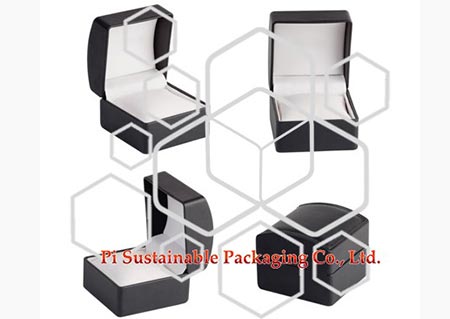What packaging is suited for jewelry items?
Sep 03,2024 | Views: 929
When packaging jewelry items, it’s essential to strike a balance between aesthetics, protection, and branding. Here's a breakdown of the types of packaging suited for jewelry:
- Features: Often lined with soft fabric (like velvet or silk) to cushion the jewelry.
- Use: Ideal for high-end pieces like rings, necklaces, and bracelets.
- Features: Drawstring closures; some come with additional padding.
- Use: Great for delicate items like earrings, pendants, or bracelets.
- Benefits: Lightweight, easy to store, and adds a touch of elegance.
- Features: Provides a clear view of the product while offering protection.
- Use: Suitable for lower to mid-range items, especially for retail displays.
- Benefits: Affordable and tamper-evident.
- Features: Pre-cut holes or slits to secure earrings, necklaces, or bracelets.
- Use: Popular for smaller items like earrings or pendant necklaces.
- Benefits: Great for branding; often used by artisan or boutique jewelers.
- Features: Can be branded with logos and designs.
- Use: Often used for gift presentations, usually in conjunction with other packaging like boxes or pouches.
- Benefits: Adds an extra layer of luxury; reusable.
- Features: Provides cushioning during shipping.
- Use: Essential for protecting items during transit.
- Benefits: Affordable and effective for preventing damage.
- Features: Used to wrap around the jewelry item or to line boxes.
- Use: Adds a decorative touch while offering minimal protection.
- Benefits: Enhances unboxing experience.
- Features: Tailored to match the brand’s aesthetics, often with unique shapes, materials, or branding elements.
- Use: Perfect for creating a memorable unboxing experience.
- Benefits: Enhances brand recognition and customer loyalty.
- Protection: Ensure the packaging provides adequate protection, especially during shipping.
- Eco-Friendliness: Consider using sustainable materials to appeal to environmentally-conscious consumers.
- Cost: Balance the cost of packaging with the value of the jewelry item.
Conclusion
Choosing the right packaging for jewelry involves considering the type of jewelry, brand identity, and the unboxing experience you want to provide. Whether it's a luxurious jewelry box or an eco-friendly pouch, the right packaging can elevate your product and leave a lasting impression on your customers.
Prev: How do you pack a jewelry business?
Next: What is the worlds most expensive Jewellery box?
1. Jewelry Boxes
- Material: Commonly made from cardboard, wood, or metal.- Features: Often lined with soft fabric (like velvet or silk) to cushion the jewelry.
- Use: Ideal for high-end pieces like rings, necklaces, and bracelets.
- Benefits: Offers excellent protection and a luxurious presentation.
2. Pouches
- Material: Typically made from velvet, silk, organza, or suede.- Features: Drawstring closures; some come with additional padding.
- Use: Great for delicate items like earrings, pendants, or bracelets.
- Benefits: Lightweight, easy to store, and adds a touch of elegance.
3. Blister Packs
- Material: Clear plastic casing attached to a cardboard backing.- Features: Provides a clear view of the product while offering protection.
- Use: Suitable for lower to mid-range items, especially for retail displays.
- Benefits: Affordable and tamper-evident.
4. Custom Jewelry Cards
- Material: Sturdy cardboard or paper.- Features: Pre-cut holes or slits to secure earrings, necklaces, or bracelets.
- Use: Popular for smaller items like earrings or pendant necklaces.
- Benefits: Great for branding; often used by artisan or boutique jewelers.
5. Gift Bags
- Material: Paper, fabric, or plastic.- Features: Can be branded with logos and designs.
- Use: Often used for gift presentations, usually in conjunction with other packaging like boxes or pouches.
- Benefits: Adds an extra layer of luxury; reusable.
6. Bubble Wrap and Padded Mailers
- Material: Plastic bubbles or padded envelopes.- Features: Provides cushioning during shipping.
- Use: Essential for protecting items during transit.
- Benefits: Affordable and effective for preventing damage.
7. Tissue Paper and Wrapping
- Material: Soft, thin paper.- Features: Used to wrap around the jewelry item or to line boxes.
- Use: Adds a decorative touch while offering minimal protection.
- Benefits: Enhances unboxing experience.
8. Custom Packaging
- Material: Varies depending on the design.- Features: Tailored to match the brand’s aesthetics, often with unique shapes, materials, or branding elements.
- Use: Perfect for creating a memorable unboxing experience.
- Benefits: Enhances brand recognition and customer loyalty.
Key Considerations:
- Branding: Packaging should reflect the brand's identity and target audience.- Protection: Ensure the packaging provides adequate protection, especially during shipping.
- Eco-Friendliness: Consider using sustainable materials to appeal to environmentally-conscious consumers.
- Cost: Balance the cost of packaging with the value of the jewelry item.
Conclusion
Choosing the right packaging for jewelry involves considering the type of jewelry, brand identity, and the unboxing experience you want to provide. Whether it's a luxurious jewelry box or an eco-friendly pouch, the right packaging can elevate your product and leave a lasting impression on your customers.

 English
English 日本語
日本語 Français
Français Deutsch
Deutsch Español
Español
